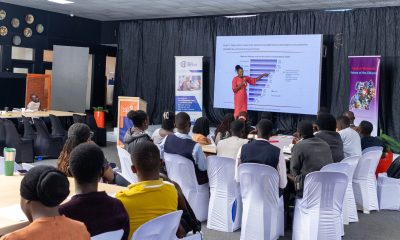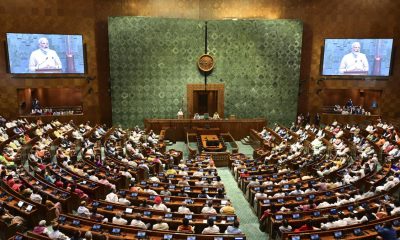Analysis
Biotechnology, a step to achieving industrialization in Uganda

Large scale commercial farming is taking root in Northern Uganda. Soy farmers stand to benefit from herbicide tolerant varieties when it is released by Makerere University and if the legal environment can allow the farmers to access it
The Minister of Finance Matia Kasaija proclaimed ‘Industrialization for job creation and shared prosperity’ as the theme for Uganda’s current financial year budget 2018/19. The theme fits well within the wider aspirations of the African Union and the African Development Bank that seek to achieve self-sustaining food secure and modern economies for the member countries across the continent.
In his Foreward to a landmark research study by the African Development Bank titled: Industrialise Africa, Strategies, Policies, Institutions and Financing’ the President of the African Development Bank Dr. Akinwumi Adesina observed that: “The secret of the wealth of nations is clear: developed nations add value to everything they produce, while poor nations export raw materials. Africa must quit being at the bottom of the global value chains and move to rapidly industrialize, with value addition to everything that it produces. Africa must work for itself, its people, not exporting wealth to others.”
Dr. Adesina concluded by noting that: “Diversification is not a goal. It is the outcome of well-planned policies for the structural transformation of economies. No region of the world has moved to industrialized economy status without passing through the transformation of the agricultural sector. This is the formula: agriculture allied with industry, manufacturing and processing capability, equals strong and sustainable economic development and wealth creation throughout the economy.
The bottom line is that we need to produce more and we need to produce better. Most of all, we
need to add value to our resources and raw materials, and turn them into processed products.”
From Dr. Adesina’s argument, it goes without saying that Uganda’s industrialization must necessarily start with agricultural modernisation. This is because it’s the widest sector, and employs the highest number of people.
Ugandan economists also emphasise that the country’s competitive advantage lies in transforming the agricultural sector. It is the sector that has the biggest potential to transform the economy into an industrialised country because of its ability to provide raw materials for local as well as foreign industries while at the same time empowering the millions of people that depend on it with good incomes that enable them to purchase goods that may be produced by import-substituted factories.
Trade facts also confirm Uganda currently depends on exports of unprocessed goods to other countries and receives a fraction of the amount of money that consumers of those products pay for the finished goods. For example, coffee consumers pay 5 pounds for half a kilo of roasted coffee beans which they grind for domestic use.
On the other hand, Uganda spends billions of dollars to import goods from China and India, and other Asian countries that achieved their current economic status thanks largely to the economic policies of their governments that emphasised agricultural transformation in the seventies which helped to lift millions of the people from poverty.
For Uganda to transform her agriculture, experts argue, the country needs to embrace science and technology especially in the agricultural sector as the first step on the road to industrialization.
Although Uganda’s agricultural development strategy acknowledges the need to develop agricultural value chains as a necessary aspect for value addition to our products, some critics fault the government’s commitment and willingness to nurture the fragile sector. They cite the repeated claims that prices of goods are determined by forces of demand and supply as simply unrealisitc and escapist.
Peter Wamboga Mugirya, the Director of Communications at the Science Livelihoods and Development (SCIFODE) cited the successes of countries like South Korea, Vietnam to the government’s deliberate strategy to develop their country’s agricultural sector.
“Vietnam had a bitter war with the United States for nearly a decade. So many lives were lost, but at the end of the war, the government took a deliberate policy to promote coffee and cassava development. Today the country is one of the leading producers of Cassava and Coffee in the world,” said Wamboga.
He also cites the deliberate policy by the Nigerian government to substitute wheat imports with locally-grown cassava as having helped to develop the Cassava value chain in the country Currently, he says, Nigerian scientists are trying to develop cassava varieties that are rich in Vitamins.
In the aftermath of Green Revolution of the 1960s and 70s, which was characterised with adoption of higher-yielding monoculture crops, heavy use of chemicals, the world now has better tools to spur agricultural development.
Modern biotechnology, which involves the use of living things or parts of living organisms to counter pests, diseases and other stresses, is considered to be the most appropriate technology for achieving economic transformation.
Role of biotechnology in industrialization
Increased productivity
The advent of biotechnology over the past two decades, has been associated with increased productivity arising from higher-yielding varieties such as hybrids but also drought tolerant and pest resistant varieties that are able to withstand hash climate and other stresses.
The adoption of maize hybrids, herbicide tolerant varieties in the United States and several other countries in South America and Asia is credited with the sharp increase in productivity in those countries.
Experts argue that Uganda urgently needs to adopt modern biotechnology science because it faces more critical challenges compared to the US and Brazil of this world. Uganda’s maize yields for example are some of the lowest in the world, at 550kgs per acre, about ¼ of Africa’s maize production, 1/6th of yields in Asian countries and 1/10th in developed countries.
Uganda’s dismal yields are partly attributed to outdated habits of relying on farmer-saved seed, failure to apply fertiliser and climate stresses especially drought and low levels of mechanisation. Because of the shameful low yields, farming has become a poverty trap for millions of people in Uganda, as they continuously ensure that farmers are perpetually tied to loans from traders in order to meet basic needs.
Although total maize output in Uganda has increased in recent years, much of the realised increment has come from expansion of the cultivated area, and mostly through destruction of forest cover and wetlands than through increased output per unit area.
And although the government’s agricultural development strategy stresses the development of value chains, the continued export of raw produce is an indictment on the part of the government and betrayal of its commitment towards industrialization.
AFDB’s Industrialize Africa report observed that industrialization is a process that almost by default starts with the transformation of the agricultural sector.
Celestine Monga, AfDB’s Vice President and Chief Economist, argues in the report that: “The economic development of today’s industrialized countries was almost universally accompanied by an increase in agricultural productivity in the initial stages of development. Sustained economic development typically requires that agriculture, through higher productivity, provides food, labour, and even savings to the process of urbanization and industrialization. A dynamic agricultural sector raises labour productivity in the rural economy, pulls up wages, and gradually eliminates the worst dimensions of absolute poverty.”
Need to match rapid population, reduce foreign exchange loss
Whereas maize, the country’s most grown cereal and largest export crop by volume, has increased in recent years, overall food production has not been able to match the rate of population growth. Recent statistics indicate that the agricultural sector has grown with an average of 2.6% over the past decade compared to population growth of 3 percent.
The decline in per capita food production, has resulted into increased expenditure on imported food such as rice and wheat. Wheat products such as Rolex, Chapatis, Bread have for example become a staple foods in urban centres. The African Development Bank is one of the agencies that have raised the alarm of the huge haemorrhage of foreign exchange on food alone. The bank says that Africa spends more than US$35bn on food imports alone and threatens to rise to US$110bn as early as 2025.
According to AfDB President Dr. Akinwumi, increased food imports decimates Africa’s agriculture and exports jobs to countries that export food.
Other countries such as Ethiopia and Kenya have abandoned their earlier opposition to modern biotechnology by tagging their industrialisation policies to the value chain development for crops such as cotton and maize.
Expand markets through diversification
Biotechnology has empowered breeders in different to develop varieties with specialist qualities that are demanded by different industries. Samuel Opio, the Chief Pharmacist at Cipla Quality chemicals, revealed for example that they import starch from countries that have adopted GM technology for use in drug manufacturing. He however noted that suppliers obtain starch from maize that is bred specifically for its high starch content.
Other biotechnology tools such as herbicide tolerance in soy and maize has allowed farmers to weed using selective herbicides with machines as opposed to the use of the hand hoe.
Experts however warn that biotechnology is not a silver bullet for the challenges facing the continent. The role of government in creating a market, supporting nascent and fragile sectors is key to ensuring that agriculture delivers on its potential as the foundation for the industrialization process.
The recent glut maize production experienced across Uganda last season, saw some farmers abandoning the unharvested maize in the field because of very low prices. In a meeting that was hosted by the National Agricultural Research Organisation (NARO), in Kampala in August this year, farmers complained about a lack of market.
But a number of experts pushed the responsibility of creating a market towards the government. Asaph Niwagira, an official from the African Development Bank, Uganda Office, argued that without assuring farmers of a market, production has remained low.
Resolutions from that meeting noted that government has a fundamental role to play in creating a market for the produce by the farmers. This can be through policy changes that provide incentives and imposes restrictions on imported substitutes, market research among others.
Experts pointed at the possibility for example, of the government influencing breweries to substitute barley with maize in beer production.
In the final analysis, although economists have tended to argue that countries that pull out of poverty are those that move away from agriculture, it’s important to note that majority if not all the countries that industrialized, start by transforming their agriculture. Evidence shows that biotechnology, is one vital tool that can contribute towards the transformation of the sector.
Also as noted by the AfDB in its High 5 strategic goals; Ie; Light up & power Africa, Feed Africa, Industrialize Africa,
Integrate Africa and Improve the quality of life for the people of Africa, improved other factors such as increased energy are important to achieve industrialization.
Comments



























